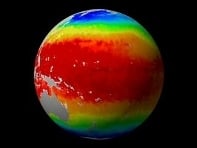Is El Niño a theory or a proven fact?
The Paita sailors, who frequently navigate along the coast in small craft, either to the north or the south of that port, name this countercurrent the current of "El Niño" (the child Jesus) because it has been observed to appear immediately after Christmas.

El Niño as a physical occurrence is a proven fact. The way it works is a theory (actually several different theories).
El Niño is as real as other weather phenomena: thunderstorms, for instance. We recognize its characteristics as similar to previous occurrences, and note that its life cycle is roughly the same each time. (Of course each one is somewhat different, as each thunderstorm is different, but the basic evolution is similar enough that we know an El Niño when we see it).
On the other hand, a difference from thunderstorms is that we have a very good idea what triggers thunderstorms, what conditions make it likely for them to occur, to the point where weather forecast models commonly pinpoint the locations and predicted severity of thunderstorms a day or so in advance. We do not have such knowledge for El Niño. Once an El Niño has started, we have reasonably good skill in predicting the subsequent evolution over the next 6-9 months, but before it has started we have very little skill in predicting the onset before the event has become obvious. There are a variety of theories for why El Niños start, but none of them has given us real skill in making a forecast in advance, the way we can for thunderstorms.
It must be said that there is still plenty of social utility in predicting the evolution of an El Niño after it starts, since that gives 6 months or so warning before the effects come to the US. For instance, a fairly weak El Niño started earlier this year (2002), and that enables forecasters to predict that the coming winter is likely to be warmer than normal across the northern states, and wetter than normal along the Gulf Coast (sorry!). Such forecasts are certainly useful for farmers and water managers, but from a scientific point of view they are unsatisfying because they do not answer the fundamental question of why the event started in the first place.
One reason for this state of affairs is that El Niños only come along every 4-5 years or so, so there aren’t very many to study (we’ve had decent instrumentation in the tropical Pacific for less than 20 years). Thunderstorms happen every day in summer, so there’s been lots of opportunity to carefully observe their development.
I wonder if you are asking a deeper question, though, concerning the meaning of the word “theory”. In science, we use the word theory somewhat differently from ordinary usage. Ordinarily, to say something is a theory means it is kind of a guess, not proven.
Scientists, on the other hand, speak of the “theory of gravitation”, or the “theory of evolution”, and in that case it means the precise description of the mechanism. In no way does it indicate that the phenomenon in question is less than a fact. No one doubts that gravity is a fact, but the exact way it works is still a subject of research (Einstein spent the last 40 years of his life trying to explain gravitation without simply postulating it, that is, to explain it in connection with the other atomic forces.
This is still a major question of physics, and you may have heard of the search for a “unified field theory”). Similarly, no serious scientist doubts that evolution is a fact, but there is plenty of discussion about its specific mechanisms, whether it happens fast or slowly, what size population of an organism is likely to produce new species, under what conditions a species will die out, etc). All these are part of honing the theory.
In the case of El Niño, one theory is that these events are the means by which heat is drained from the equatorial oceans after a period of accumulation. Such a theory predicts that by observing the growth of heat content, it should be possible to forecast when an El Niño will occur. That seems to be at least partly true, but it was contradicted by the El Niño of 1993, which occurred immediately after one the previous year, and no accumulation had occurred.
Another theory argues that El Niños are triggered by random events occurring in other parts of the climate system, and suggests that we will never be able to predict them. Some scientists argue for an opposite (cold) phase called La Niña, and see the whole thing as an oscillation swinging back and forth, while others think there is just the normal situation disturbed by occasional El Niños. However, you can see that despite the existence of competing theories for El Niño, there is no doubt that it is a real, factual occurrence.
Information courtesy of NOAA.
This article was published by the staff at Farmers' Almanac. Do you have a question or an idea for an article? Contact us!






